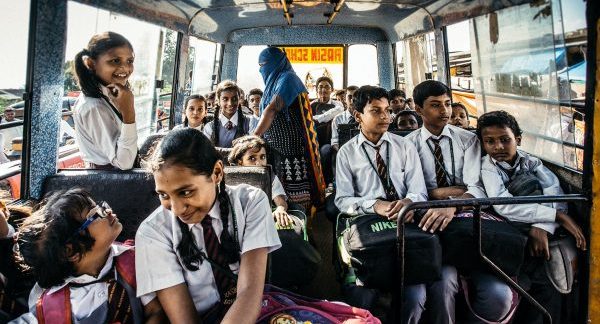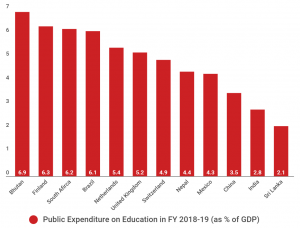
A Missed Milestone: How India has been Unable to Boost Public Education Spending to 6% of GDP
5 May 2022
The National Education Policy (NEP) 2020, India’s guiding policy document on achieving equitable and quality education for all, has reiterated the need for increasing public investment in the education sector to a minimum of 6 per cent of its Gross Domestic Product (GDP) at the earliest. However, in 2021-22, the budgetary allocation for education spending, by the Union government and the states combined, was far less at 3.1 per cent of the country’s GDP. A large gap between the 6 per cent target and actual status of investment has remained for many decades now. Why?
Firstly, it is important to understand the history behind the rationale of setting the 6 per cent benchmark.
THE INITIAL DECADES OF SHAPING PUBLIC INVESTMENT ON EDUCATION
In 1964, towards the end of the third Five-Year Plan, the Kothari Commission was created to review the education system of the country. Its role was to advise the government on the general principles and policies for development of education. Among its recommendations was, for the first time ever, that education expenditure as a share of Gross National Income (GNI) be increased from 2.9 per cent in 1965-66 to 6 per cent by 1985-86.
This recommendation was based on certain assumptions with respect to economic growth, population growth, and the growth in enrolment numbers [1]. In order to achieve this target by 1985-86, the Commission said, the pace of economic growth needed to be faster in the subsequent decades starting from 1965-66, and that there be a dedicated effort at population control. For ready reference, Table 1 captures the broad assumptions of the Kothari Commission, and the targets set for every successive Five-Year Plan period.
Table 1: Education Expenditure Targets Estimated by Kothari Commission: 1965-66 to 1985-86

The Commission recognised that it could be difficult to maintain the expected growth rates for each of the background parameters consistently on an annual basis to achieve the 6 per cent target. It thus recommended employing a variety of combinations as supporting parameters. These included reaching economic growth ranging from 5 to 7 per cent per annum; population growth ranging from 1.5 to 2.5 per cent per annum; and dedicating a proportion of national income to educational expenditure ranging from 4 to 6 percent over 20 years.
Additionally, the 6 per cent target was recommended on the basis of those of economically advanced countries like Japan, USA, and erstwhile USSR. The expectation was that education expenditure would grow at almost double the rate of economic growth in the early stages [2].
HOW THE 6 PER CENT TARGET HAS REMAINED ELUSIVE
From 1951 to 1966, during the first three Five -Year Plans, about 7 per cent of the total budget expenditure, on average, was spent on education. After the Kothari Commission’s proposal for education expenditure was accepted by the Union government, the National Policy on Education (NPE) 1968, stated that the country should aim “…to increase the investment in education to reach a level of expenditure of 6 per cent of the national income as early as possible’’. The proportion of GNP spent on education doubled from 1.7 per cent in 1968-69 to 3.5 per cent in 1985-86, but flattened to 3.4 per cent in 1986-87 [3].
Thus, till the late 1980s the target could not be achieved. Subsequently, another policy – the NPE 1986 – emphasised the need for equitable access to educational opportunity and making sufficient funds available for education by increasing public expenditure to reach the same target in the subsequent years. But, even during the period when India saw high economic growth (1986-87 to 2001-02), allocations for the education sector remained low. If we look at actual expenditures, between 2015-16 to 2018-19, India spent less than 3 per cent of its GDP on education.
Figure 1: Government Expenditure on Education as a Percentage of GDP

Thus, public education spending could not reach the benchmark set by these policies. The release of NEP 2020 has been visionary since it has introduced new approaches for education delivery and the goal of universalisation of school education from pre-primary to secondary grades by 2030, along with recommending the same target of 6 per cent [4].
WHY 6 PER CENT IS A CONSERVATIVE TARGET
It is equally important to highlight here that the 6 per cent target was set considering the denominator to be GNI, which is theoretically higher than a country’s GDP. Therefore, when education expenditure is calculated as a share of GDP, the target should have ideally been slightly higher than 6 per cent. Secondly, the target is already a conservative one as it was based on somewhat grim parameters, such as high pupil-teacher ratio at the primary level; a smaller proportion of investment on schools for capital expenditure; no provision of free uniforms, free stationery, free school meals, Information and Communication Technology (ICT), etc. With these services currently being provided, the scope of public investment is much higher. Also, earlier estimates do not include pre-primary education, which the NEP 2020 now envisages.
Similarly, in the case of higher education, the Kothari Commission used unit costs for the year 1965-66 that were much lower, for estimating resource requirements. It also recommended less expensive part-time and correspondence courses for about 30 per cent of the students. Keeping in mind the limited resources at that time, it recommended carefully planned expansion of higher education over the decades. Therefore, any fresh estimate of the public investment requirements target should ideally be higher than 6 per cent in the current context.
In all, the fact that India has not been able to achieve the relatively conservative target of 6 per cent for almost four decades now, is an area of major concern. It seems to be still stuck on reiterating a goal for public investment in education, which was originally envisaged to be achieved by 1985-86. This is more so because there is still a large proportion of children not accessing school education beyond elementary level in the country. According to Shah, the more unfortunate and disturbing long-term trend in this regard is the slackening of government effort to mobilise required resources during the high economic growth period from 1986 onwards compared to low economic growth (1966-1986) [5].
The next blog in the series looks at India’s current status on the achievement of the 6 per cent target and the discrepancy around the indicator due to the methodology and definitional issues used in its calculation.
References
[1] Tilak, J. B. (2006). On allocating 6 per cent of GDP to education. Economic and Political Weekly, 613-618.Available online at: https://www.epw.in/journal/2006/07/perspectives/allocating-6-cent-gdp-education.html
[2] Vol 4: Planning, Administration, Finance. Education Commission Report, 1964-66. Available online at: http://14.139.60.153/bitstream/123456789/186/1/Report-Education%20and%20National%20Development-Vol-4-Planning%2C%20Administration%2C%20Finance.pdf.
[3] Tilak, J. B. (2018). The Kothari commission and financing of education. In Education and Development in India (pp. 255-282). Available online at: http://rteforumindia.org/wp-content/uploads/2018/10/The-Kothari-Commission-and-Financing-of-Education_Tilak.pdf
[4] New Education Policy, 2020, MHRD,GoI. Available online at: https://www.education.gov.in/sites/upload_files/mhrd/files/NEP_Final_English_0.pdf
[5] Shah, K. R. (2006). State inaction in Education in India. Journal of Educational Planning and Administration, 20(4), 465-472. Available online at: http://niepa.ac.in/New/download/Publications/JEPA_(15%20years)/JEPA%202006_Vol-20%20(1-4)/JEPA_OCT-2006-VOL20_4%20Final.pdf#page=7
Also Read: Budget 2022 Increases Education Spending, Samagra Shiksha Scheme Key For School Reopenings
Also Listen to: Yamini Aiyar on the Education Pandemic





